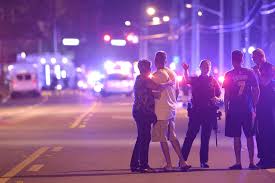Credit: yplsbrent.org
In the moments before they died, some of the victims of the Pulse nightclub massacre in Orlando reached for their phones to send texts to let their loved ones know what was going on. A number of these texts have been shared on the internet, where the public can read the harrowing last calls for help and the haunting last declarations of love. One CNN video used a compilation of these last texts to piece together a timeline of what was happening inside the club during the three hours that the shooter had hostages trapped inside. Among the most heartbreaking were the words 30-year-old accountant Eddie Justice typed to his mother while he was hiding in the bathroom of the nightclub. “Mommy I love you,” he wrote. And then, “I’m gonna die.”
The immediacy of texting provides a quiet, discreet, and instantaneous way of communicating with those not in the immediate vicinity, and gives victims of a tragedy the opportunity to communicate final words that might otherwise go unsaid. In this way, it provides a way to connect with those we love when we fear we may not see them again.
Since texting has taken over as a primary mode of communication, we have been privy to more and more final texts sent by victims of tragedies widely reported by the media. We’ve seen frightened last texts sent by passengers of doomed flights and the “I love you” texts sent by victims of mass shootings as they barricaded themselves in bathrooms and classrooms. These final messages provide a haunting window into the experiences of victims in their last moments before death.
Sometimes the public’s fascination with these last texts seems to border on morbid. But we have always had an intense interest in famous last words and deathbed statements; perhaps it is our way of gather clues about what it is like to die. We’re curious. We want to know, or at least we think we do. These final texts also have the power to create a more visceral kind of empathy, as they bring the victims back to life for a moment, showing us a glimpse of them while they were trying to reconcile themselves to unexpected catastrophe.
Prior to texting, people facing imminent and unexpected death have scrawled dying words on paper, on the walls of prison cells or in the dirt in an attempt to communicate with the world one last time. A note found in a journal spattered with blood lying on the body of a Union soldier in Cold Harbor read simply “I was killed.” In a final note to his wife, Aldous Huxley wrote “LSD, 100 micrograms I.M.” (In case you’re wondering, she fulfilled his request and injected him twice before he died. )
More recently, Julie Swann-Paez, a health inspector who was shot when armed men massacred fourteen people at a holiday party, texted her family “Love you guys. Was shot.” Swann-Paez survived, but she wanted to make sure her last words to her family were that she loved them. It seems that the ability to send a final text is comforting for the sender, an avenue by which to fulfill that last impulse to connect before they die.
Maureen Keeley, a professor of communications at Texas State University, has been researching the last words shared between loved ones before one of them died for 16 years, and has seen recurrent themes appear. In an interview with the Washington Post, she explains, “You have no control at the end. But now we have this little snippet of control over our communication — to know that, at least I got to say goodbye, I got to say ‘I love you.'” But the experience on the part of the receiver is more complicated, she warns. While the texts might provide some sense of closure or solace for some, others who receive frightened texts from their dying loved ones might be haunted by those last words.
Yet, Eddie Justice’s family says they are grateful for the texts he sent to his mother from the Pulse nightclub restroom the night he was shot. “My family is happy that my mom had the opportunity to talk to him and be able for respond to him in that moment,” his sister said. His mother was able to be with him, via technology, in a way that was just not possible before texting became the norm.

 Last Texts
Last Texts





 How Dare You Die Now!
How Dare You Die Now!

 “Help Me, Helen”
“Help Me, Helen”














